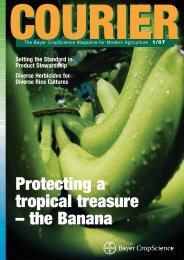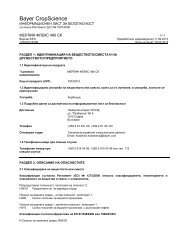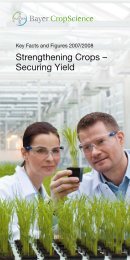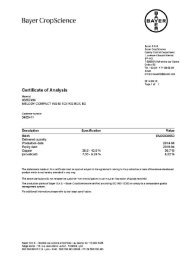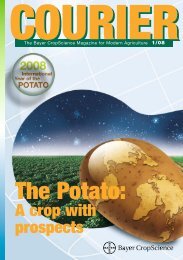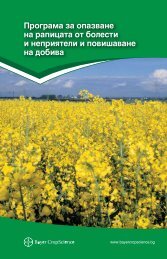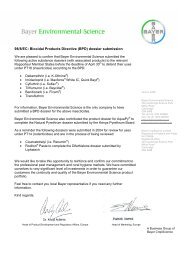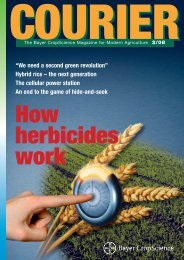For healthy potatoes - Bayer CropScience
For healthy potatoes - Bayer CropScience
For healthy potatoes - Bayer CropScience
You also want an ePaper? Increase the reach of your titles
YUMPU automatically turns print PDFs into web optimized ePapers that Google loves.
versely, its weaknesses. <strong>For</strong> diseases such<br />
as snow mould, the duration of protection<br />
provided by a product can sometimes be a<br />
critical factor.<br />
Beyond controlling pathogen fungi,<br />
seed-treatment has traditionally served to<br />
prevent infestation by pests. Examples<br />
include bird repellency, and the control of<br />
wheat bulb fly. One important area is the<br />
control of aphid species, especially those<br />
that act as vectors of barley yellow dwarf<br />
virus.<br />
The quality of the<br />
formulation underlies the<br />
success of seed-treatment<br />
The quality of a seed-treatment product<br />
is not simply determined by its spectrumof-action.<br />
Other factors are also involved<br />
in determining, for example, the compatibility<br />
of the various components of the<br />
treatment with the crop plant. The formulation<br />
– i.e. the mixture comprising the<br />
product – significantly influences crop<br />
compatibility: water-based products are<br />
Seed treatment should<br />
therefore not only be judged on<br />
the basis of cost. It should also<br />
be considered as an insurance<br />
policy, and this is reflected<br />
in the higher price paid<br />
for treated seed.<br />
generally more favourable here than solvent-based<br />
formulations. However, the<br />
most important determinants of a formulation’s<br />
crop compatibility are the active substances<br />
it contains. <strong>For</strong>merly, the triazoles<br />
were often implicated as a source of problems:<br />
they were included in the formulation<br />
to increase the spectrum-of-action; but<br />
the high doses used were often enough to<br />
jeopardize crop compatibility. Nowadays,<br />
the combination of the different compounds<br />
used must be considered together<br />
with the type of formulation. Here it is also<br />
the case that differences in compatibility<br />
among seed-treatment products only tend<br />
to become obvious when the plant is<br />
stressed. Delayed emergence can usually<br />
also be attributable to external factors such<br />
as temperature, soil conditions and other<br />
factors.<br />
There has been a general trend towards<br />
developing new products as water-based<br />
formulations, although not so much with<br />
crop compatibility in mind, but rather with<br />
the intention of improving<br />
the protection of the<br />
user and non-target<br />
organisms in the environment.<br />
These factors (and of<br />
course, the cost of a<br />
product) are important,<br />
but technical quality is<br />
becoming an increasingly<br />
significant determinant<br />
of the competitiveness<br />
of individual<br />
seed-treatment products.<br />
Here, the physico-chemical properties of<br />
the formulation are also a basis for differentiating<br />
between products: they have a<br />
significant influence on how easy it is to<br />
work with the product. Together with the<br />
equipment used, they determine the quality<br />
of the treated seed lots, and are among the<br />
most important criteria for the selection of<br />
a particular product by the operators of a<br />
seed-dressing unit. If a product constitutes<br />
a hazard to operators, or if the poor workability<br />
of a formulation causes technical<br />
problems during the peak work times in<br />
autumn and spring, then it has little chance<br />
of remaining on the market, even if it<br />
shows good biological efficacy and is<br />
cheap. Working methods within seedpreparation<br />
units often mean that universal<br />
treatments are preferred, because they<br />
allow a switch between the different cereal<br />
types without the need for extensive cleaning<br />
of equipment. Switching between<br />
mutually-incompatible water- and solventbased<br />
formulations is a particular problem<br />
– it requires careful cleaning of equipment,<br />
which can mean complicated planning and<br />
can lead to time-pressure.<br />
As we have seen, the quality of a seedtreatment<br />
can be defined using a number<br />
of parameters. But the overriding aim of<br />
this process of optimization is to ensure<br />
that the product gives consistent control of<br />
the pathogen or pest, allowing optimal<br />
seedling emergence and crop establish-<br />
30 COURIER 2/06






